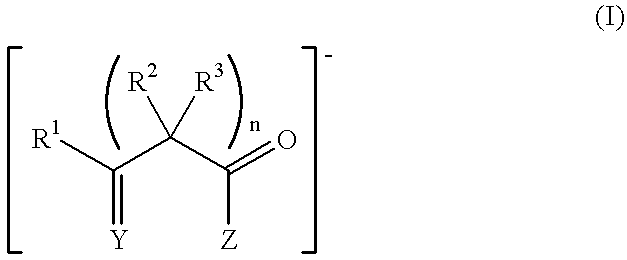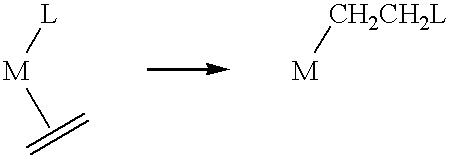Polymerization of olefins
a technology of olefins and polymerization, which is applied in the field of polymerization of olefins, can solve the problems of reducing the stoichiometric amount (relative to the polar comonomer) of lewis acid, affecting the stoichiometric amount of lewis acid,
- Summary
- Abstract
- Description
- Claims
- Application Information
AI Technical Summary
Problems solved by technology
Method used
Image
Examples
example 2
Synthesis of 1
[0180] In a drybox, A (0.500 g) was mixed with 0.251 g of nickel allyl chloride dimer in 30 mL THF. The color of the solution turned from deep red to yellow brown in a minute. The mixture was stirred for 14 h. THF was evaporated. The yellow solid was extracted with 30 mL toluene. The mixture was filtered through Celite.RTM., followed by 3.times.5 mL toluene wash. The solution was concentrated to ca. 5 mL and was added to 50 mL of pentane. The solid product was filtered, washed with 3.times.10 mL pentane and dried in vacuo. Yellow solid was obtained (0.424 g, 66% yield). .sup.1H NMR (in CD.sub.2Cl.sub.2): .delta. 7.16-7.27 (m, Ar--H, 3H); 5.68 (hept, central allyl-H, 1H); 3.35 [m, overlapped syn-allyl-H (d, 1H) and (CH.sub.3).sub.2CH--, (m, 1H), total 2H]; 2.92 (m, (CH.sub.3).sub.2CH--, 1H); 2.35 (d, .sup.3J=13.2 Hz, anti-terminal-allyl-H, 1H); 2.01 (d, .sup.3J=6.0 Hz, syn-terminal-allyl-H, 1H); 1.91 (s, N.dbd.C--CH.sub.3, total 3H]; 1.87 (d, .sup.3J=13.2 Hz, anti-termi...
example 3
Synthesis of 2
[0181] In a drybox, A (1.500 g) was mixed with 0.753 g of nickel allyl chloride dimer in 50 mL THF. The mixture was stirred at RT for 5 h. THF was evaporated. The residue was extracted with 70 mL toluene. The mixture was filtered through Celite.RTM., followed by 3.times.10 mL toluene wash. To this solution under stirring was added 2.9082 g B(C.sub.6F.sub.5).sub.3. The solution was allowed to stir for 2 h. The cloudy solution was filtered through Celite.RTM., followed by 3.times.10 mL toluene wash. The filtrate was concentrated to dryness. The residue was dissolved in ca. 20 mL methylene chloride, followed by addition of ca. 150 mL pentane. The orange solid was filtered, washed with 3.times.10 mL pentane and dried in vacuo. Orange solid was obtained (1.450 g, 30% yield). .sup.1H NMR (in CD.sub.2Cl.sub.2): .delta.7.22-7.35 (m, Ar--H, 3H); 5.72 (hept, central allyl-H, 1H); 3.42 (d, syn-terminal-allyl-H, J=8.5 Hz, 1H); 3.22, 2.81 (m, CH.sub.3).sub.2CH--, 1H each]; 2.44 (d,...
example 4
Synthesis of 3
[0182] In a drybox, to a TiCl.sub.4 THF solution (0.3522 g in 20 mL THF) was added 0.5000 g A in portions at RT. The resulting mixture was allowed to stir overnight. The mixture was then filtered through Celite.RTM., followed by 2.times.5 mL THF wash. The filtrate was evaporated to dryness. The resulting solid was dried in vacuo. Black crystalline solid (0.9026 g) was obtained.
PUM
| Property | Measurement | Unit |
|---|---|---|
| pressure | aaaaa | aaaaa |
| θ | aaaaa | aaaaa |
| bonding distance | aaaaa | aaaaa |
Abstract
Description
Claims
Application Information
 Login to View More
Login to View More - R&D
- Intellectual Property
- Life Sciences
- Materials
- Tech Scout
- Unparalleled Data Quality
- Higher Quality Content
- 60% Fewer Hallucinations
Browse by: Latest US Patents, China's latest patents, Technical Efficacy Thesaurus, Application Domain, Technology Topic, Popular Technical Reports.
© 2025 PatSnap. All rights reserved.Legal|Privacy policy|Modern Slavery Act Transparency Statement|Sitemap|About US| Contact US: help@patsnap.com



